Tourcode: UP2
- Overview
- Info & Inclusions
- Itinerary
- Map & Hotels
- Photos
- Dates & Prices
- Max Group Size 18
- Stark & dramatic southern Bolivia Altiplano
- Untouristed, charming Paraguay
- Colonial charms of Uruguay
- UNESCO protected Jesuit ruins
- Winery tasting & lunch
- Stunning and varied natural splendours
- Remote, breathtaking Northwest Argentina
- High Andes, coastal scenery, vibrant cities
- Singles friendly (view options for single travellers)
Paraguay is what parts of Argentina were like 30 years ago, with an un-touristed and authentic colonial charm.
Northwest Argentina, with its isolated and distinct Andean culture, is one of the most "indigenous" regions in the southern Andes, and Bolivia constitutes the quintessential Andean experience.
The lifestyle here is laid-back and ruggedly elegant, with soaring peaks, plunging gorges, endless salt flats set as dramatic backdrops to leafy colonial plazas, chic galleries, trendy restaurants, and unfailingly friendly local smiles.
- Full-time Tour Leader services with local guide support at various locations.
- Breakfast daily, several lunches, and most dinners (hotels & local restaurants) as per the tour itinerary.
- All transport (including internal flights), accommodation, sightseeing and entrance fees for sites noted as 'visited' in the detailed itinerary.
- Gratuities for local guides, drivers, restaurant staff, porters.
- Domestic flights via local scheduled carriers as per the itinerary.
- Airport transfers for land & air customers.
- International airfare to/from the tour.
- Tour Leader gratuities, lunches, some dinners (per the tour itinrary), drinks, personal items (phone, laundry, etc), international (if applicable), visa fees/departure taxes, any excursions referenced as 'optional'.
- Airport transfers for Land Only customers.
- Our post-reservation trip notes offer further guidance on optional meal costs, entry requirements, and shopping.
- Seasonality and Weather:
This tour is offered twice a year: For both times, lower elevations benefit from cooler temperatures. In Bolivia, the start of the dry season, from April-May, has fewer crowds and still feels fresh from the recent rains. Oct-Nov are also dry but a bit warmer, as spring approaches and crowds disperse.
Elsewhere, we'll have warm-hot days on the coast and at lower elevations and comfortably warm days/cool nights at higher levels. We visit a large area on this trip and the conditions we encounter will be quite varied -- from cool/cold and dry higher regions of the Andes (subject to sudden showers), to lush forests and semi-tropical inland and coastal regions. Overall, however, these are two of the best times to visit these destinations, before the height of summer when it can be hot, crowded, and expensive in some locales. - Transport and Travel Conditions:
Ground transport by private air-conditioned motor coach, 24-36 seats depending on ultimate group size (see 'group size') and location. Though we will have some full bus days, roads are generally in good condition (rougher in NW Argentina) though a little winding on some stretches. In the Bolivian Alitplano, we'll be divided between several comfortable 4x4 vehicles.
We feature numerous optional walking opportunities and walking tours on uneven surfaces. This tour is not strenuous in terms of physical activities, but in order to fully enjoy and experience the sites visited, you must be prepared for considerable walking at a leisurely pace.
Hotels generally provide baggage handling, but you must still be independent with your luggage.
We also have a couple of internal flights via domestic carriers, which can in itself be fatiguing (you will have to be able to manage your luggage). This is definitely a full itinerary with plenty of moving around!
One important consideration is the time spent at high altitude in Bolivia during the first week of the tour. We will be above 3100m/10,000 and, in some locations, above 3600m/12,000 ft. Travellers with pre-existing medical conditions should consult their physician; we will visit some very remote locations with limited access to healthcare. As such, all travellers will be required to complete a medical "self-assessment" form in order to affirm their suitability. To preview this form, please click on the "Resources" tab at the top of this page.
Our "Level 2" rating refers to the overall ambitious nature of the program, the tremendous amount of moving around we do, some early starts and full days of travel and activities, leisurely walks at sites and short walks to dinner, and a brief time spent at high elevation.
Am I suitable for this tour? Please refer to our self-assessment form - Activity Level: 2
These are particularly busy tours that feature a lot of moving around, sometimes by train and short journeys on local transport. Walking tours of towns and cities are leisurely but you should be prepared to be on your feet for several hours. Some of our cultural trips that occur at high altitude and/or require greater independence with baggage handling (at hotels, airports, train stations) also fall into this category.
To learn more about the Activity levels, please visit our tour styles page. - Accommodation:
Well-located, air-conditioned/heated, upper-range hotels and inns (3-5* star) used throughout. All hotels have en suite toilet and bath, though some may have shower only (ie no tub). Porter service is usually available (see 'inclusions') though you should be independent with your luggage, especially at airports. Single rooms are limited in number and likely smaller than twins.
* Please click on "Map & Hotels" tab for more information. Note that some of our preferred hotels in Bolivia rate themselves 5-star based on a local rating system; internationally, they might be considered more of a 4-star.
Please click on "Map & Hotels" tab for more information - Staff and Support:
Tour Leader throughout, local guides at several locations, multiple drivers. - Group Size:
Maximum 18 plus Tour Leader
- Day 1:Arrival in La Paz, BoliviaWelcome to La Paz, one of the world's highest capital cities at 3,686 metres (12,090 feet) above sea level. The city sits hidden in a dramatic bowl-shaped canyon carved into the Altiplano, invisible until the high plateau suddenly drops away 400 metres (1,312 feet) to reveal the sprawling cityscape below. This geological drama has shaped La Paz's character - neighbourhoods climb the canyon walls in tiers, with the wealthiest residents occupying the lower, oxygen-rich areas while poorer communities perch higher on the rim.
This evening we gather with fellow travellers for our first meal together.
Overnight in La Paz.
Included Meal(s): Dinner, if required - Day 2:La Paz: City TourAfter breakfast at the hotel, we explore La Paz's well-preserved Spanish colonial quarter. The city sits beneath mountains averaging 5,500 metres (18,040 feet), dominated by the snow-capped triple peak of Mount Illimani at 6,402 metres (21,000 feet). Our tour includes the Precious Metals Museum and the Murillo Museum before continuing to Plaza Murillo, where the Cathedral, Government Palace, and National Congress buildings cluster around the historic square.
Later we walk through the Mercado de los Brujos, the Witch's Market, where vendors sell potions, herbs, and folk remedies used to guard against evil spirits. Dried llama foetuses hang alongside medicinal plants - traditional offerings for Pachamama (Mother Earth) that builders bury in foundations for good fortune. The market offers a window into Andean mysticism and the daily life of the colourfully-dressed Quechua and Aymara-speaking people. The women wear layers of petticoats beneath bright pollera skirts, carrying groceries or babies in striped aguayo blankets slung over their shoulders. Their signature bowler hats - always appearing slightly too small and worn at jaunty angles - arrived with British railway builders and became part of traditional Andean dress.
We ride the city's cable car system, now the world's longest urban cable car network. The Mi Teleférico has transformed how paceños navigate their vertical city while offering visitors elevated views across the canyon. We finish at the Valley of the Moon, where erosion has carved the clay hillside into a landscape of spires and canyons that resemble the moon's surface.
Overnight in La Paz.
Included Meal(s): Breakfast and Dinner - Day 3:La Paz: Lake Titicaca & Isla del SolAn early start takes us to Copacabana, a site of religious pilgrimage dating back to Inca times. Every year, hundreds of thousands of pilgrims travel from across Bolivia and Latin America for religious festivals here. The town's massive basilica houses the Dark Virgin of Copacabana, a 16th-century statue carved by indigenous artist Francisco Tito Yupanqui. Local legend warns that if the statue is ever removed, Lake Titicaca will rise up and flood the entire Altiplano.
After a brief visit, we board a catamaran to explore Lake Titicaca and Isla del Sol, the most sacred of the lake's islands. Lake Titicaca straddles the Bolivia-Peru border at 3,810 metres (12,497 feet) above sea level. The lake once extended far beyond its current 8,560 square kilometres (3,305 square miles) - the great city of Tiwanaku was built at the water's edge, but today sits more than 25 kilometres (15 miles) inland. This dramatic reduction transformed the Altiplano's climate over the past thousand years.
Our journey continues at the Inti Wata Cultural Complex, featuring exhibits on traditional medicine, living practices, and reed ship building. The complex includes a sailing experience aboard a traditional reed vessel for a visit to the Pilkokaina Inca Palace.
We return to the catamaran for a buffet lunch on board before making our way back to La Paz.
NOTE: Due to our early start, large lunch, and possible early departure tomorrow, dinner is not included this evening.
Overnight in La Paz.
Included Meal(s): Breakfast and Lunch - Day 4:La Paz: Tiwanaku RuinsToday we visit Tiwanaku, a UNESCO World Heritage Site located 72 kilometres from La Paz near the shores of Lake Titicaca. The Tiwanaku Empire dominated portions of southern Peru, northern Chile, and eastern Bolivia for approximately six hundred years (500-1100 CE). At its peak, Tiwanaku ranked among the world's largest cities, with perhaps 20,000 to 40,000 inhabitants thriving at altitudes between 3,800 and 4,200 metres despite frequent frosts and thin soils. The civilisation developed sophisticated raised-field agriculture and extensive trade networks that brought tropical goods from the Amazon and coastal products from the Pacific.
Around 1100 CE, the civilisation collapsed as a regional force. Evidence suggests climate change, including decreased rainfall and dropping groundwater levels, caused agricultural systems to fail throughout the empire. Whether environmental catastrophe alone explains Tiwanaku's end remains debated among archaeologists.
We explore the Kalasasaya Sun Temple, whose name means "standing stones" in Aymara, referring to the massive vertical pillars that once enclosed the temple platform. The semi-subterranean Earth Temple features walls studded with carved stone faces, each one unique. The Akapana Pyramid, though largely unexcavated, once stood seven terraces high. We also see the Gateway of the Sun, a single block of andesite weighing approximately 10 tons and covered with intricate carvings, including the central figure of the "Gateway God." Our visit includes the museum housing ceramic objects, tools, and textiles from Tiwanaku and earlier cultures.
Overnight in La Paz.
Included Meal(s): Breakfast and Dinner - Day 5:La Paz - Fly to Sucre - Parque Cretacico - SucreThis morning we fly to Sucre, Bolivia's constitutional capital and UNESCO World Heritage Site. The city's wealth of Spanish colonial architecture earned its designation. Sucre shares capital status with La Paz: Sucre houses the Supreme Court and serves as the constitutional capital, while La Paz functions as the seat of government. The city maintains an important university and a large indigenous population who preserve traditional clothing and customs.
We begin with a visit to Parque Cretacico, where dinosaur tracks discovered accidentally in 1994 reveal prints nearly 70 million years old. The tracks, preserved in what was once the muddy shoreline of a vast inland sea, belong to numerous species. The site contains one of the world's largest and most diverse collections of dinosaur footprints, with over 5,000 individual tracks identified across a massive limestone slab now tilted nearly vertical by tectonic forces.
After lunch, we tour Sucre's colonial centre, visiting the Casa de la Libertad, where Bolivia's declaration of independence was signed in 1825. At the Museo del Tesoro, displays showcase Bolivia's precious and semi-precious stones. We also visit the Asur Textile Museum, which preserves remarkable indigenous weaving traditions. We view the exterior facades of San Lazaro and Santo Domingo churches, along with other historical monuments and Bolivar Park.
PLEASE NOTE: This will likely be a painfully early departure due to limited flight options (one morning, one late afternoon). Though not ideal, a morning flight serves our itinerary better than the alternative. The changeability of internal flight times over the next few days (up to and including our flight to Asuncion) could result in adjustments to the final itinerary.
Overnight in Sucre.
Included Meal(s): Breakfast, Lunch and Dinner - Day 6:Sucre - Potosi - ColchaniThis morning we travel by road to Potosi (approximately 3 hours), a UNESCO World Heritage Site sitting at 4,090 metres (13,500 feet) - among the world's highest cities. The 1544 discovery of silver in Cerro Rico prompted the city's foundation in 1545. Within decades, Potosi exploded into one of the world's largest and wealthiest cities, its population reaching nearly 200,000. More than eighty churches served this boom town, and the phrase "valer un potosi" entered Spanish as a synonym for unimaginable wealth.
This wealth came at tremendous cost. Hundreds of thousands of indigenous workers and African slaves died in the mines under the brutal mita system of forced labour. According to official records, 45,000 tons of pure silver were mined between 1556 and 1783.
On arrival we visit the city's principal sites, including San Lorenzo Church with its elaborate facade combining European and indigenous artistic traditions. We admire the exterior of the Arch of Cobija and browse the artisans' market.
At the Casa Nacional de la Moneda, we explore the massive facility that operated continuously for 400 years until 1953. Inside, we see the original minting machinery - enormous wooden presses turned by mules - along with galleries displaying colonial art. The mint mark of Potosi may have inspired the dollar sign, though this theory remains disputed.
After our tour, we continue to our hotel in Colchani, gateway to the Uyuni salt flats.
NOTE: We regret if our flight-driven itinerary changes closer to departure have us visiting places on a Sunday when some sites may be closed.
Overnight in Colchani.
Included Meal(s): Breakfast and Dinner - Day 7:Uyuni: Area SightseeingIn the environs of Uyuni we experience the Salar de Uyuni, the world's highest and largest salt flat at 10,000 square kilometres, sitting at 3,656 metres (11,995 feet) above sea level. The salt flat formed when prehistoric lakes dried up thousands of years ago, leaving a thick crust of salt and minerals. On the flat's edge, we watch local inhabitants extracting salt using ancient methods - cutting blocks from the crust, piling them to dry, then processing the salt for iodisation. En route we visit the villages of Chaquila and TikaTika.
After lunch, we visit the old railway depot in Uyuni, where rusting locomotives sit abandoned - haunting reminders of Bolivia's 19th-century railway ambitions. British engineers built these lines to transport minerals from the Andes to Pacific ports. When mining declined, the railways were abandoned, and the desert's dry air has preserved the locomotives in their slow decay.
We continue to Incahuasi Island in the heart of the salt flat. This isolated outcrop is populated with giant cacti that can live over a thousand years, some growing up to 12 metres (40 feet) high. From the island's summit, 360-degree views reveal the salt flat stretching to the horizon in every direction.
Our hotel near Colchani village is entirely constructed of salt blocks - walls, floors, and furniture carved from compressed salt. After dinner you can stroll the surroundings and enjoy the stars in the unpolluted, cloudless skies.
Overnight in Colchani.
Included Meal(s): Breakfast, Lunch and Dinner - Day 8:Salar Uyuni Area SightseeingToday's 4x4 excursion takes us to the north side of Uyuni Salt Flat to view the Coquesa Mummies, human archaeological remains in a small cave near Tunupa Volcano. Ceramic, gold and copper artifacts, and articles of clothing discovered at some sites indicate the presence of an advanced but little-known culture. Unfortunately, the sites' remoteness has left them vulnerable to amateur treasure hunters who have plundered items of archaeological value.
As our visit coincides with the dry season (April to November), the salt flat surface provides unique opportunities for perspective photography. The perfectly flat, white surface and clear horizon create optical illusions - distance becomes impossible to judge, allowing creative photos where people appear to stand in someone's hand or balance on bottles.
We return to Colchani for overnight.
Included Meal(s): Breakfast, Lunch and Dinner - Day 9:Uyuni - Fly to Santa CruzToday we transfer to Uyuni's airport for our flight to Santa Cruz de la Sierra, connecting with tomorrow's flight to Asuncion. Since we'll likely find ourselves with time in Santa Cruz, we'll shed some layers and explore upon arrival.
Located in eastern Bolivia just over 400 metres above sea level, Santa Cruz enjoys year-round warm temperatures thanks to a semi-tropical savanna climate. The contrast with the high Altiplano could hardly be more stark - from windswept salt flats and frigid nights to humid lowlands and lush vegetation. Rich in oil, natural gas, forest products, and agriculture, the city enjoys a dynamic economy and generates over 35% of Bolivia's GDP. Santa Cruz also serves as Bolivia's most populous city, having overtaken La Paz in recent decades as migrants from the highlands sought economic opportunities in the booming lowlands.
We visit the historic centre where we can appreciate the Minor Basilica of San Lorenzo, the Prefectural Palace, and the colonial architecture of Bolivia's east. The city's main plaza, surrounded by arcaded walkways, follows classic Spanish colonial planning. We explore the Regional History Museum, with displays on local customs and the Chiquitana cultures who inhabited this region before Spanish colonisation.
Overnight in Santa Cruz.
Included Meal(s): Breakfast and Dinner - Day 10:Santa Cruz, Bolivia - Fly to Asuncion, ParaguayThis morning we fly to Asuncion - welcome to Paraguay! Depending on our flight schedule we may fit in some sightseeing in Santa Cruz this morning or accomplish some Asuncion sightseeing upon arrival.
Asuncion was founded on August 15, 1537 - the Feast of the Assumption, or Asuncion in Spanish. As one of the oldest cities in South America and the longest continually inhabited area in the Rio de la Plata Basin, it's known as "Mother of Cities." Colonial expeditions departed from here to found other settlements throughout the region, including the second foundation of Buenos Aires in 1580. This historical primacy gave Asuncion outsized importance during the Spanish colonial period, though its influence waned as Buenos Aires and other coastal cities grew more powerful through Atlantic trade.
Today Asuncion remains Paraguay's capital and largest city, home to approximately 2.5 million people in the greater metropolitan area. The city sits on a bay where the Paraguay River widens before continuing south to meet the Parana.
Overnight in Asuncion.
Included Meal(s): Breakfast and Dinner - Day 11:Asuncion: City TourToday we explore one of South America's oldest capitals. The city displays a colonial character with colourful patios and red tiled roofs. From the river's east bank, the city spans out into gentle hills overlooking the bay, with beautiful flowering trees, native fauna, and lush gardens throughout.
We start with the Casa de Independencia. Built in 1772, the building housed the secret meetings that led to the 1811 declaration of independence from Spain. The house has been preserved as a museum with period furnishings and displays documenting Paraguay's path to independence - notably, Paraguay was among the first South American colonies to break from Spanish rule.
Our tour takes in the Barro Museum, housing a world-class collection of indigenous folk art. We stop at the Government Palace, a gleaming white building overlooking the bay, before visiting the Pantheon of National Heroes. This neoclassical building, modelled on Les Invalides in Paris, serves as a memorial to Paraguay's war dead. Pausing here, we reflect on the country's turbulent history, particularly the catastrophic War of the Triple Alliance (1864-1870) which killed an estimated 60-70% of Paraguay's population. We also visit the Cathedral of Our Lady of Asuncion and the Teatro Municipal.
Overnight in Asuncion.
Included Meal(s): Breakfast and Dinner - Day 12:Asuncion - Ruta Jesuita - EncarnacionToday we head southeast to discover the ruins of the Jesuit Reductions, Christian settlements established to convert, teach, and protect native Guarani communities. These intricate buildings are little visited but evocative of an extraordinary era when the Guarani were taught architecture, music, and craftwork by Jesuit missionaries.
Ruins of Jesuit missions spread across Paraguay, Argentina, Brazil, and Bolivia today. The Spanish and Portuguese empires adopted a strategy of gathering native populations into communities called "Indian Reductions." The objectives were to organise indigenous labour while imparting Christianity and European culture. The Jesuits, however, attempted something more ambitious - a theocratic "state within a state" in which native peoples, guided by Jesuit priests, would remain autonomous and isolated from Spanish colonists and colonial exploitation. A major factor attracting natives to the reductions was protection from enslavement under the brutal encomienda system practised elsewhere in Spanish America.
At their peak in the 18th century, around 40 different communities housed more than 150,000 indigenous people, most of whom were Guarani. The missions achieved remarkable success - communities were largely self-sufficient, producing surplus agricultural goods, developing sophisticated musical traditions, and creating architectural works that rivalled European standards.
En route we pass through San Cosme and San Damian, where we visit Jesuit ruins and see the church and school still in use today.
Overnight in Encarnacion.
Included Meal(s): Breakfast and Dinner - Day 13:Jesuit Missions, Paraguay - Encarnacion, ArgentinaWhen the Jesuits were expelled from the Spanish realm in 1767 - the result of political intrigue and the order's growing power - the reductions slowly died out. Some communities were absorbed into mainstream colonial society, while others became victims of slave raids. Today some former reductions continue as towns, while most have been abandoned and remain only as ruins.
We explore several Jesuit Missions in the Parana and Itapua areas of Paraguay, including the ruins of La Santisima Trinidad. Rarely does one find a UNESCO World Heritage Site with so few visitors, but that's only part of the attraction. A walk around the atmospheric red-brick hilltop ruins allows you to absorb a sense of what once made these 17th and 18th century communities so powerful. The Jesuit ruins of Trinidad, the best-preserved in Paraguay, testify to an era when the Jesuits commanded considerable influence in these parts. The site's scale becomes apparent as you walk among the remains - church, workshops, living quarters, and plazas for a community of several thousand people.
We also visit the Mission of Jesus de Tavarangue, built in 1609 and part of the Jesuit and Guarani communities for 150 years. The ruins feature impressive brickwork, baroque details, and extensive proportions that hint at the former architectural glory of these settlements. Unlike Trinidad, Jesus remains largely unrestored, giving a better sense of how the jungle reclaimed these sites after abandonment.
Later today we cross into Argentina for our overnight.
Overnight in Encarnacion.
Included Meal(s): Breakfast and Dinner - Day 14:Encarnacion - Apostoles & Santa Maria La Mayor - L.N. AlemToday we continue to Apostoles, also known as the City of Flowers, located on a plateau scored by innumerable streams that form the characteristic falls of the Misiones region. Apostoles is home to the Juan Szychowski Yerba Mate History Museum. Yerba mate, a caffeinated tea brewed from the leaves of a native holly tree, is Paraguay and Argentina's national beverage. The drink's origins lie in Guarani tradition, but the Jesuits pioneered its commercial cultivation in their missions, creating plantations that supplied mate throughout South America.
We visit the museum before continuing to the Jesuit ruins of Santa Maria La Mayor, founded in 1626. By 1744 it held a population of 993; it was abandoned after the Jesuits were expelled from the Spanish colonies in 1767. The ruins have been overgrown by vegetation - not as well-preserved as others on our programme, but charming and evocative in their advanced state of ruin. Moss-covered walls emerge from the forest, and massive tree roots have broken through stone foundations, creating an atmospheric blend of architecture and nature.
We end our day in Leandro N. Alem, named after an Argentine politician, a founder and leader of the Radical Civic Union in the late 19th century.
Overnight in Leandro N. Alem.
Included Meal(s): Breakfast and Dinner - Day 15:Alem - San Ignacio - Wanda - Puerto IguazuThis morning (likely an early start) we depart by road for Iguazu Falls.
As we prepare to leave the Misiones behind, we can reflect on their impact and the ideals they represented. Pope Francis, in 2015, praised the Jesuit reductions as an almost utopian social and economic experiment, saying they were "one of the most important experiences of evangelisation and social organisation in history." The missions demonstrated that indigenous peoples, given protection from exploitation and slavery, could create prosperous, literate communities - a direct challenge to colonial arguments that justified enslavement.
Since it's on the way, we include our last ruined mission. The San Ignacio Mini Mission, located in the San Ignacio Valley, is one of the best-preserved. Founded in 1632, the mission features brilliant baroque architectural details. Like many others, these ruins were virtually forgotten and abandoned for decades, lost in dense vegetation until uncovered in 1897. Restoration projects in the 1940s, the film 'The Mission,' and inclusion on the UNESCO World Heritage Site list in the 1980s brought the missions world recognition.
We can also stop at Wanda, famous for its mines of semi-precious stones including agate, amethyst, topaz, and quartz. Mining companies offer guided tours through workshops and showrooms. The town was founded mostly by Polish settlers and named after a Polish princess.
We finish our day in the vicinity of Iguazu Falls, located at the confluence of the River Iguazu and the deep-flowing Parana, where Argentina, Brazil, and Paraguay converge.
Overnight in Iguazu.
Included Meal(s): Breakfast and Dinner - Day 16:Iguazu Falls AreaThis morning we have a guided tour of the falls on the Argentine side.
Here at the confluence of the River Iguazu and the Parana, three nations meet. The national park is home to more than 21,000 plant species and 400 bird species - a UNESCO World Heritage Site protecting one of South America's most biodiverse regions. The waterfalls disgorge 1,700 cubic metres (1,853 cubic yards) of water per second from a height of 70 metres (230 feet) in 275 different falls, most of which are in Argentina. On the frontier with Brazil lies La Garganta del Diablo (The Devil's Throat), a U-shaped chasm 150 metres (490 feet) wide and 700 metres (2,290 feet) long where water thunders down with overwhelming force.
The afternoon is yours to revisit paths along the upper and lower parts of the falls. The plunging water throws fine mist up to 30 metres (98 feet) into the air, weaving countless rainbows in the sun. Be sure to take rain-proof clothing. The walkways bring you remarkably close to the falling water - at some points you're standing directly above the cascades, feeling the platform shake from the water's power.
You can also take an optional boat ride to the base of the falls (extra cost), or the local bus to Iguazu Town where you can observe the tri-national frontier. Your Tour Leader can help you plan your afternoon.
Overnight at Iguazu Falls.
Included Meal(s): Breakfast and Dinner - Day 17:Iguazu - Fly to SaltaThis morning we connect with our flight to Salta (1,100 metres/3,300 feet) in the northwest corner of the country.
The city of Salta was founded on April 16th, 1582. Known as "Salta la linda" (Salta the Beautiful), it's one of the Argentine cities that has valued and preserved its colonial architectural heritage. The cityscape mixes colonial buildings with white walls and red tiled roofs alongside modern constructions, with several green spaces throughout. The variety and beauty of surrounding landscapes is compelling: mountains, valleys, gorges, and subtropical flora and fauna preserved in national parks.
Salta sits in a fertile valley that has supported agriculture for centuries, but its location also made it an important colonial trading post on routes connecting the silver mines of Potosi with ports on the Rio de la Plata. This strategic position brought wealth that funded the churches and civic buildings that make Salta's historic centre so attractive today.
Depending on our flight schedule, this afternoon we'll have a guided walking tour of Salta's highlights, most grouped around the central square: the Cathedral, the Cabildo or Town Council which houses the Museo Historico del Norte, the Museo Colonial, and the Museo de Bellas Artes. The church of San Francisco has one of the tallest church towers in the Americas at 53 metres (175 feet), and the Convento de San Bernardo now belongs to the Carmelite Order.
Overnight in Salta.
Included Meal(s): Breakfast and Dinner - Day 18:Salta - Purmamarca: Salinas GrandesToday (early start) we depart Salta for the village of Purmamarca. On arrival, we visit the famous Cerro de los Siete Colores (Mountain of Seven Colours), a geological formation where different mineral layers create distinct colour bands - reds, greens, whites, and browns stratified across the mountainside.
We begin a journey along the Cuesta de Lipan, enjoying some of the best views of the Eastern Andean Range. As we climb to the highest point of the itinerary at 4,170 metres (13,680 feet), we witness the transition from fertile highlands to desert. The vegetation changes dramatically - cacti and hardy scrub replace the lusher plants of lower elevations. Following this, we descend to around 3,600 metres for our visit to Salinas Grandes, an open white expanse of more than 100 kilometres surrounded by volcanoes, where the horizon seems endless.
The Salinas Grandes salt flat, though smaller than Bolivia's Salar de Uyuni, shares a similar origin - the evaporation of ancient lakes left thick deposits of salt. Local workers extract salt here using traditional methods, and the salt pools they create for evaporation form geometric patterns of blues and whites across the landscape. We make our descent back to Purmamarca with ample opportunities to admire the surrounding scenery.
There will be some leisure time this afternoon before we regroup for our evening meal.
Overnight in Purmamarca.
Included Meal(s): Breakfast, Lunch and Dinner - Day 19:Purmamarca - Humahuaca - SaltaWe return to Salta, making a stop at Humahuaca Gorge, another compelling point of Northwest Argentina.
The area delights with its brightly coloured rock formations created by diverse minerals and geological processes over millions of years. We see the Serrania de Hornocal, where centuries of erosion have uncovered contrasting coloured limestone bands on these saw-tooth massifs. The stripes of burgundy, ochre, green, and cream result from different minerals and sediments deposited at various periods when this area lay beneath a prehistoric sea. Some claim as many as 33 distinct colours can be discerned across the mountain's face.
UNESCO declared the entire mountain valley a World Heritage Site in 1983, recognising both the Serrania de Hornocal's wondrous peaks and the historic Inca caravan road running through the region. For thousands of years, this quebrada (gorge) served as a major trade route connecting the Andean highlands with lowland regions. The Incas incorporated it into their vast road network, and Spanish colonists later used the same route. Today, small villages in the valley maintain a mix of indigenous and colonial traditions, and the area's relative isolation has preserved traditional ways of life that have largely disappeared elsewhere in Argentina.
Overnight in Salta.
Included Meal(s): Breakfast, Lunch and Dinner - Day 20:Salta: At leisureArgentina's northwestern Salta Province has long been famous for its scenery of Andean peaks, red-rock valleys, and vineyards, but the capital city has emerged only in recent years as a bright spot on the tourist map. Efforts to encourage new hotels, restaurants, and shops are paying off in visitors attracted to Salta's updated colonial charm. Today, the old city centre is recognised as a jewel-box-size getaway, perfect for exploring on foot and appreciated for its cultural offerings, grand neo-Classical buildings, and thriving night life.
Depending on variable logistics, we may complete our city tour this morning. Otherwise, today will be a free day for you to relax or explore further. Salta's cafes are excellent places to try regional specialities like empanadas salteñas or locro (a hearty stew). The nearby Teleferico cable car climbs Cerro San Bernardo for panoramic views over the city and surrounding valley - the ride takes about 10 minutes and delivers perspectives that help you understand Salta's geography. Your Tour Leader can suggest other options based on your interests.
Overnight in Salta.
Included Meal(s): Breakfast and Dinner - Day 21:Salta - Fly to Buenos Aires: City TouringThis morning we fly to Buenos Aires, our necessary connecting point onward to Uruguay. Since we're here, we'll see a bit of this worthwhile city before crossing to the last country on our journey. In the early part of the 20th century, Argentina was among the world's richest countries, and the grand public buildings of Buenos Aires reflect this opulent era. The city is known as the "Paris of South America" for its wide boulevards and European-style architecture.
We begin our sightseeing on arrival (exact content depends on arrival time). Nearly 40% of the country's population lives in Gran Buenos Aires, which initially seems as imposing as New York or London. However, after a brief orientation, you'll find that the compact city centre is accessible and easily explored on foot, by bus, taxi, and underground (subte).
Buenos Aires developed its distinctive character through waves of European immigration, particularly from Italy and Spain, in the late 19th and early 20th centuries. This immigration transformed Argentina from a sparsely populated frontier into a cosmopolitan nation, and nowhere is this more evident than in Buenos Aires, where Italian and Spanish influences permeate the cuisine, architecture, and daily speech.
Overnight in Buenos Aires.
Included Meal(s): Breakfast and Dinner - Day 22:Buenos Aires: Walking TourToday we have a half-day walking tour.
Our first stop is the Centro Naval, one of the city's most exquisite buildings and a masterpiece of cast stone architecture. The Kavanagh Building, at the time of its 1936 construction, was South America's tallest building at about 120 metres (400 feet) with over 30 storeys. Designed as a residential structure, this Art Deco tower took more than 16 years to sell all its apartments.
Palacio Paz is perhaps the most beautiful of the Beaux Arts mansions in Buenos Aires. Built for newspaper magnate Jose C. Paz, it took almost 12 years to construct and now houses the Circulo Militar. The General Jose de San Martin Monument celebrates the general who battled against Spain in the wars of independence and is known as the founder of the Argentine nation.
The Torre Monumental (British Clock Tower), a 1916 gift from the British community, was renamed after the Falklands/Malvinas conflict. Decorated with British royal imperial symbols, the base was partly destroyed by protesters during a memorial service. Retiro Station, opened in 1915, was built with British technological assistance - four British architects designed it, and the steel structure was made in Liverpool and shipped to Argentina.
Our tour ends at the Galerias Pacifico in time for lunch. This famous shopping mall, opened in 1891, was designed to recall the Galleria Vittorio Emanuele II in Milan, with long halls, a glass cupola, and several tiers of shops.
Ask your Tour Leader about the possibility of seeing an optional Tango Show this evening (to leave this option open, we don't include dinner this evening).
Overnight in Buenos Aires.
Included Meal(s): Breakfast - Day 23:Buenos Aires, Argentina - Colonia del Sacramento, UruguayToday we travel the short distance to Uruguay by ferry/hydrofoil (have your passports handy).
Uruguay is the smallest country we visit - slightly smaller than the US state of Washington. Surrounded by Brazil and Argentina, it's blessed with a long Atlantic shoreline. Home to just over 3.4 million inhabitants, Uruguay is an important agricultural country where the human population is vastly outnumbered by cattle, sheep, and horses. The nation also enjoys a reputation as one of South America's most stable democracies.
Colonia del Sacramento is one of the Southern Cone's unappreciated gems. Founded in 1680 by the Portuguese, it occupied a strategic position almost directly opposite Buenos Aires across the Rio de la Plata. Its major importance was as a source of contraband, undercutting Spain's mercantile trade monopoly. British goods made their way from Colonia into Buenos Aires and the interior, and for this reason, Spanish forces intermittently besieged the outpost for decades.
The capital of its department, Colonia is a town of about 20,000. The streets of its historic colonial core are shaded by sycamores from the summer heat. Throughout the day, sunlight strikes whitewashed colonial buildings and the river, which lives up to its name - silvery in the morning but turning brownish by midday.
We see the Real de San Carlos, a 10,000 seat bullring built at the turn of the century. Our walking tour begins at the Puerta de Campo, the restored entrance to the old city dating from 1745. A thick, fortified wall runs south to the river. We also see Casa de Lavalleja, once home to General Lavalleja who led Uruguay's independence movement, and the ruins of the 17th century Convento de San Francisco and the 19th century Faro.
Overnight in Colonia del Sacramento.
Included Meal(s): Breakfast and Dinner - Day 24:Colonia del Sacramento - Vineyard tour - MontevideoThis morning we drive along the Uruguayan Littoral (coast) to Montevideo. The littoral fronts the Rio de la Plata and the Rio Uruguay, opposite Argentine Mesopotamia. Originally Guarani and Gaucho country, it has become the nation's most important agricultural area, its wheat fields and gardens feeding the growing population of the capital. Montevideo is a vibrant, eclectic place with a rich cultural life. The historic heart of Uruguay's capital is an unspoiled tableau of 18th and 19th-century colonial architecture.
Just after leaving Colonia, we stop at the Quinton vineyard and olive farm for an olive oil tasting. Uruguay's olive oil industry is relatively young but has earned international recognition for quality. We then continue to Bouza vineyard where we have a wine tasting accompanied by lunch. Uruguay's wine industry, though small, produces excellent Tannat - a robust red wine that has become the country's signature variety. French Basque immigrants brought Tannat vines to Uruguay in the 19th century, and the grape has thrived here, producing wines that are often compared favourably to those from its native Madiran region in southwest France.
Overnight in Montevideo.
Included Meal(s): Breakfast and Lunch - Day 25:Montevideo: City TourToday we tour the city. Main points of interest include the Old City, Constitution Square, the Cathedral, and the Colonial Town Hall. The Solis Theatre, opened in 1856, is Uruguay's oldest theatre and remains an important cultural venue. Independence Square lies at the centre, with a monument dedicated to national hero Jose Gervasio Artigas and his Mausoleum. Artigas led Uruguay's fight for independence in the early 19th century and is revered as the father of Uruguayan nationhood. Facing the square sits the Government House, which includes a museum dedicated to Uruguay's presidents.
The main commercial street, 18 de Julio, is lined with shops, cafes, and office buildings. We stop for photos at the Congress Building, constructed between 1908 and 1925 with 52 kinds of local marble and 12 types of wood. We drive past Prado neighbourhood, one of the city's oldest parks, which hosts the famous sculpture La Diligencia (The Stage Coach), and the monument to the last Charrua people - the indigenous inhabitants who were tragically nearly wiped out in the 19th century.
Next is Batlle y Ordonez Park, the Obelisk, La Carreta (Covered Wagon) monument, and the Soccer Stadium. Uruguay's football tradition punches well above the country's size - the national team has won the World Cup twice (1930 and 1950) and hosted the first World Cup in 1930. We stop at Plaza Virgilio and a monument dedicated to Fallen Soldiers of the Navy, from which we have excellent views of the city. Our return route takes us along the coast and beaches.
Overnight in Montevideo.
Included Meal(s): Breakfast and Dinner - Day 26:DepartureDeparture from Montevideo.
BUEN VIAJE!
Included Meal(s): Breakfast
Countries Visited: Argentina, Bolivia, Paraguay and Uruguay
*The red tour trail on the map does not represent the actual travel path.
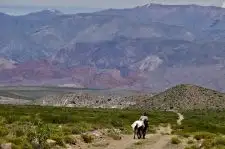


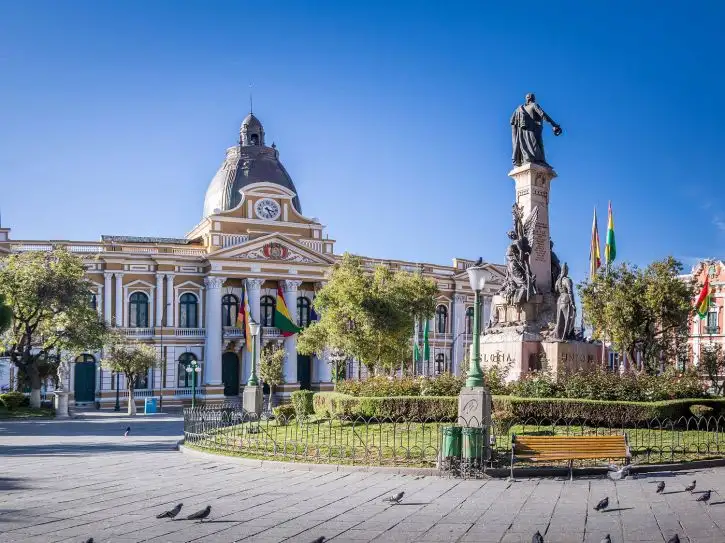


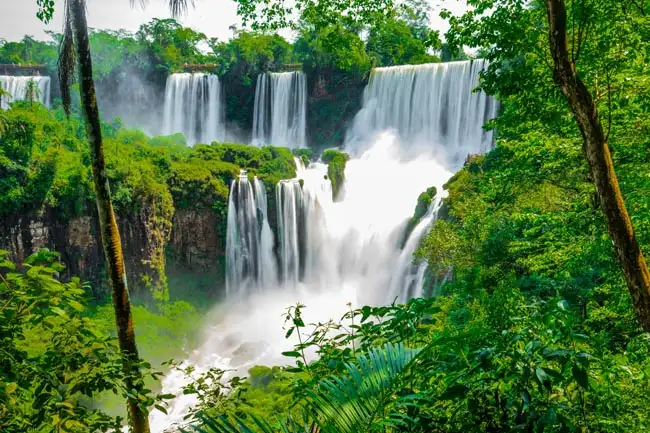


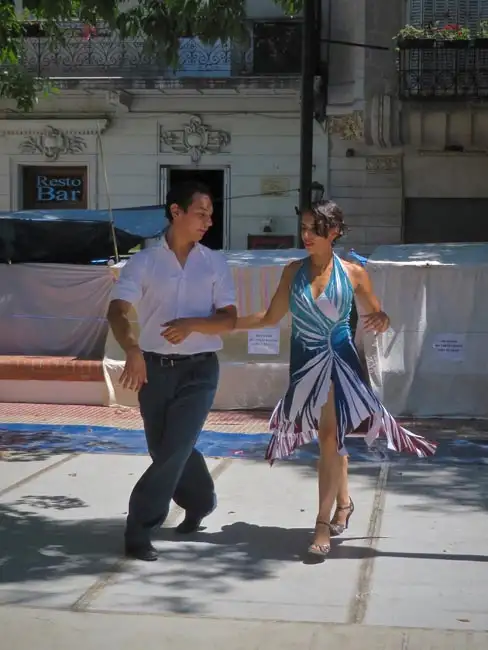
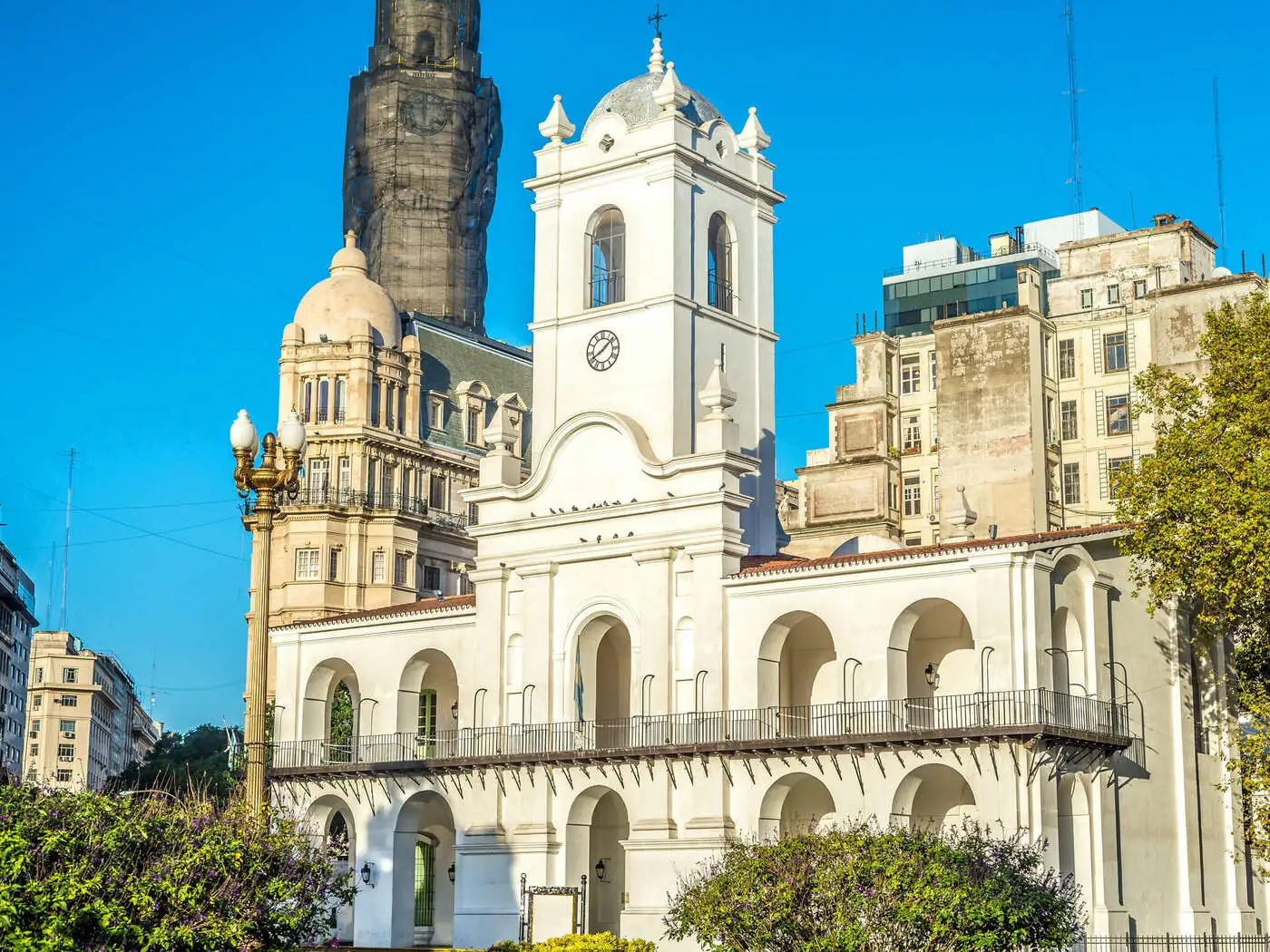
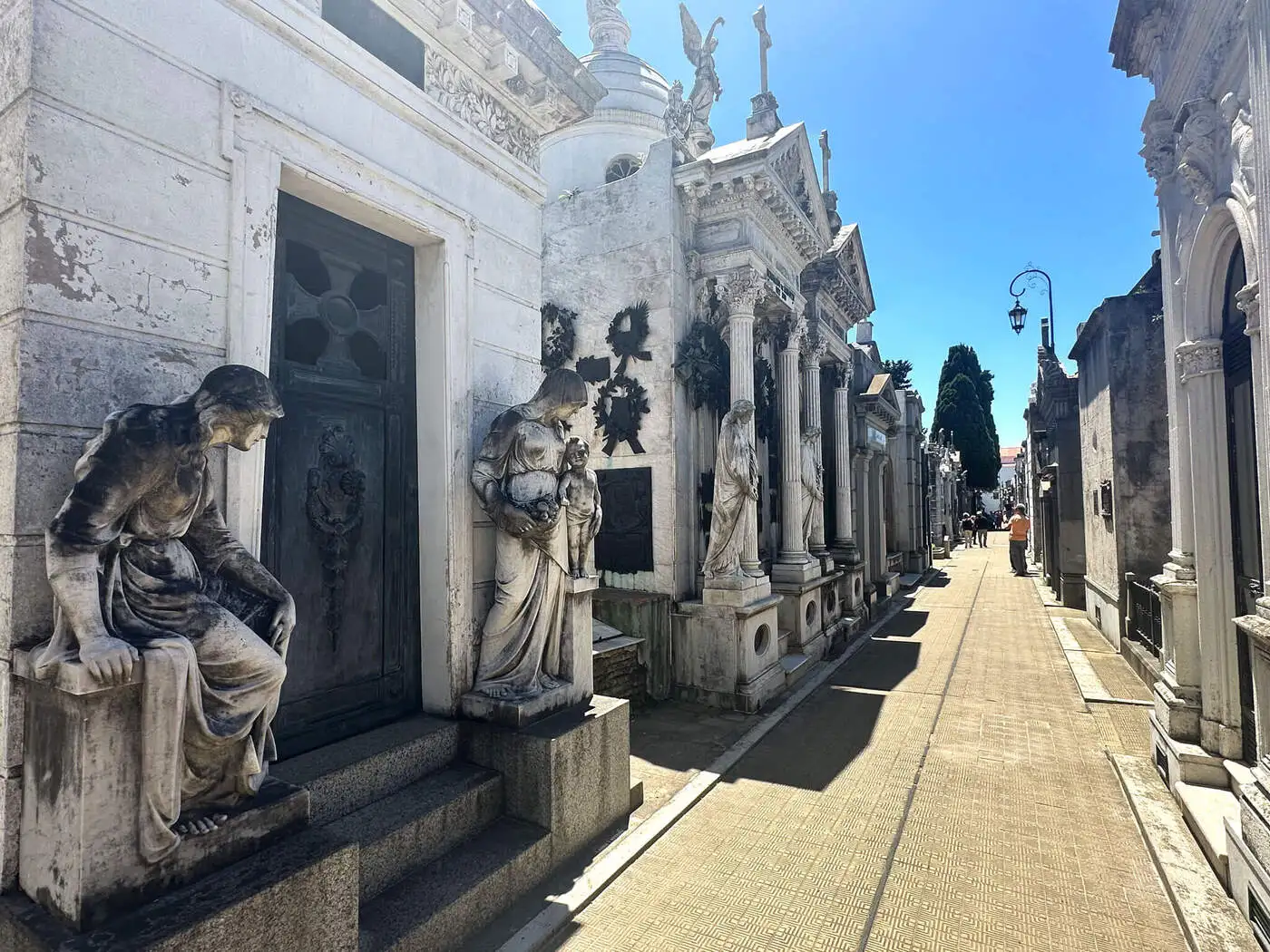
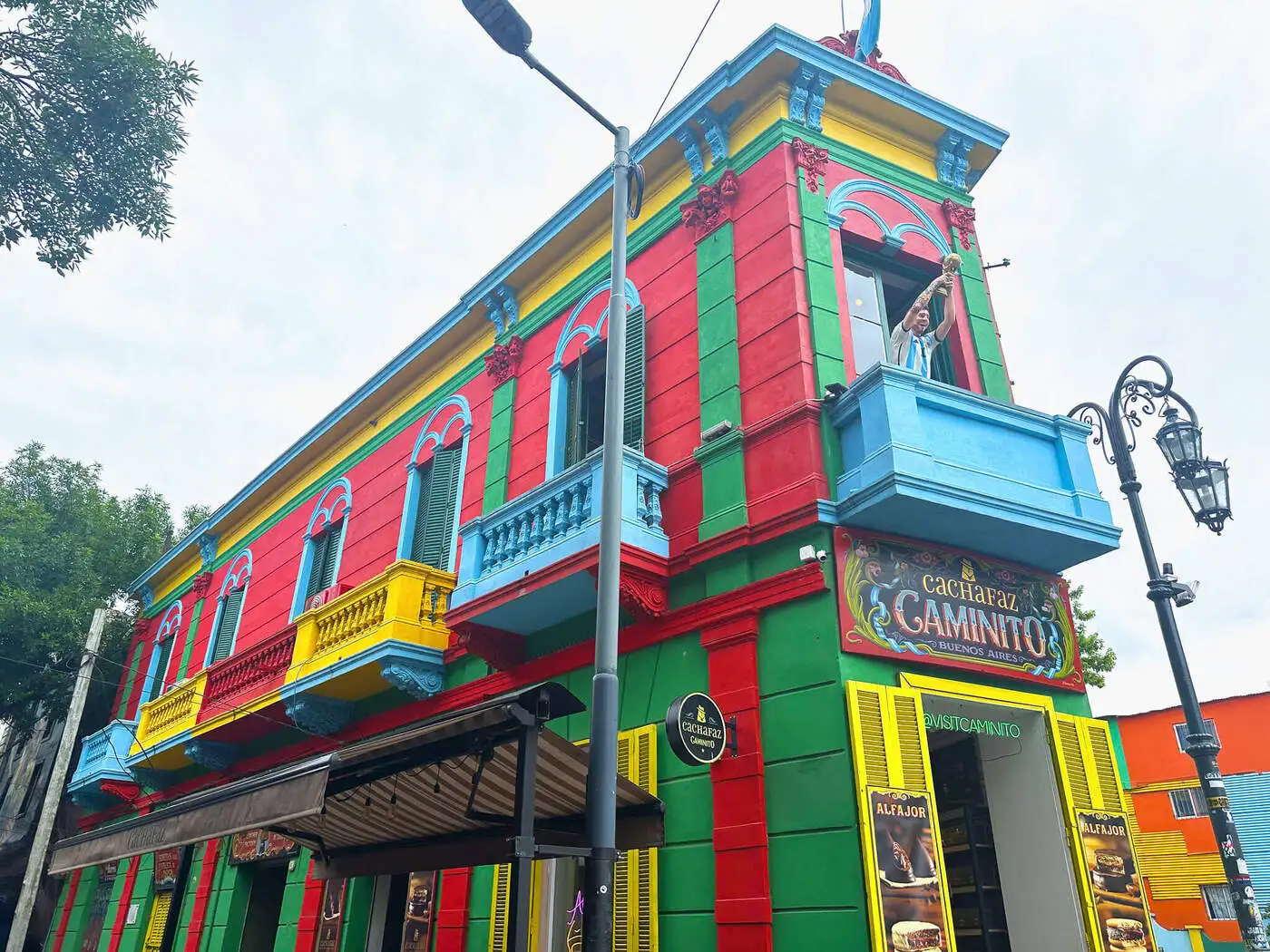

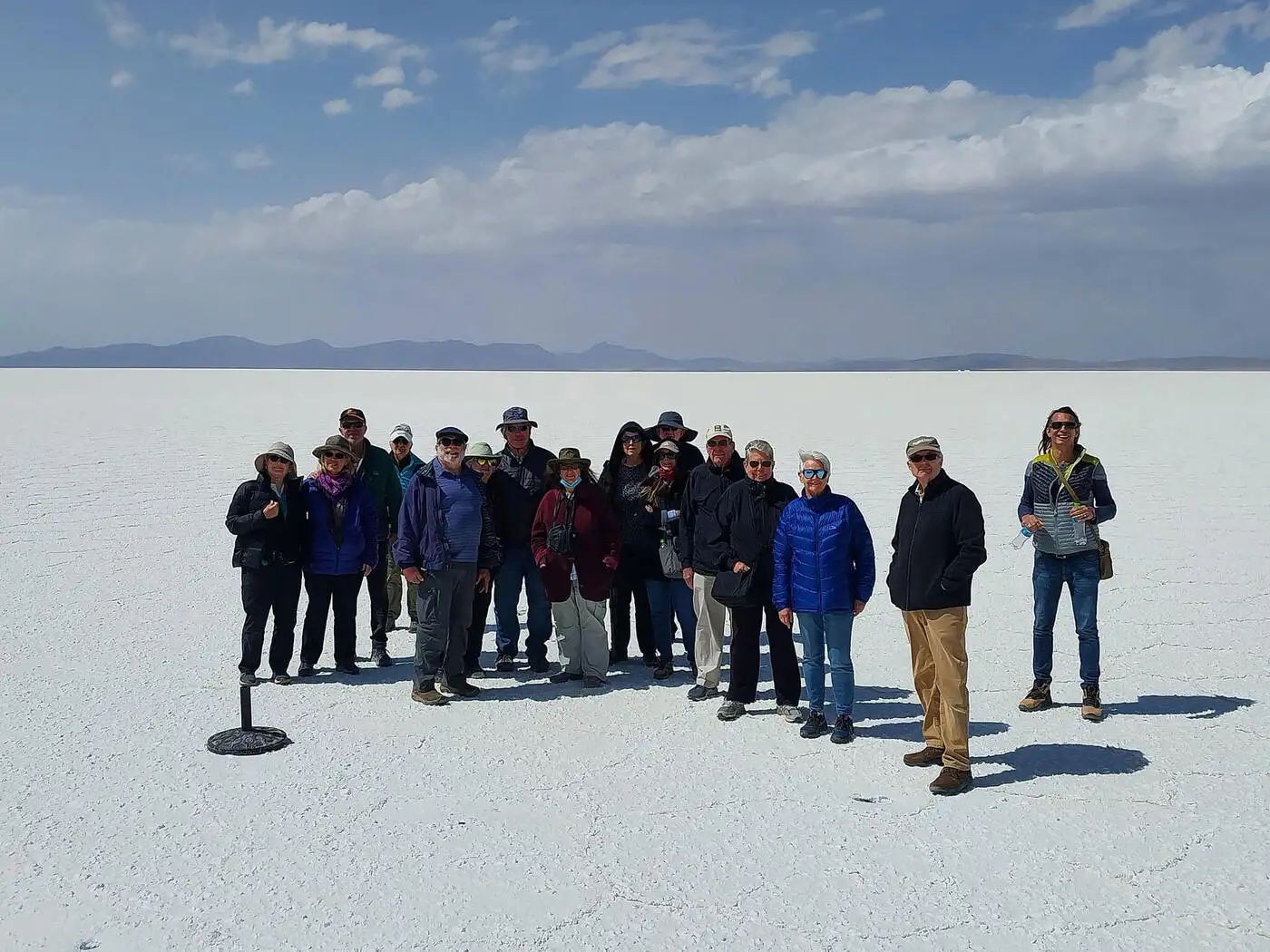

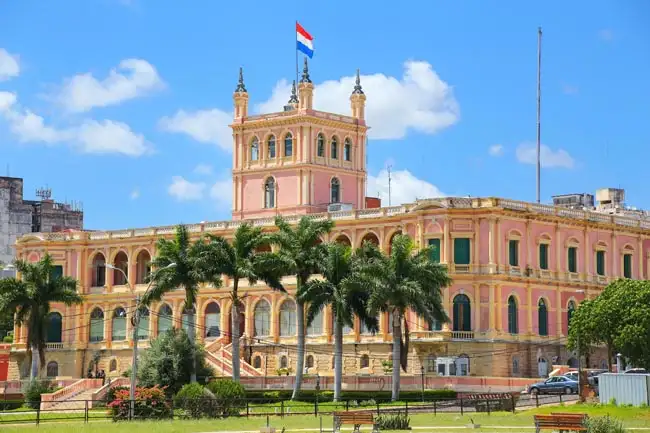
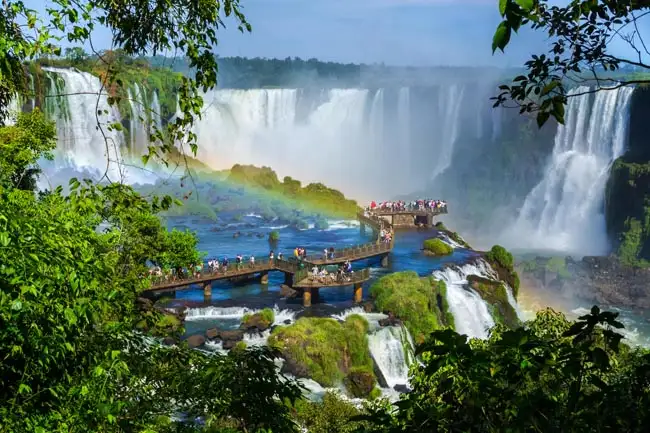

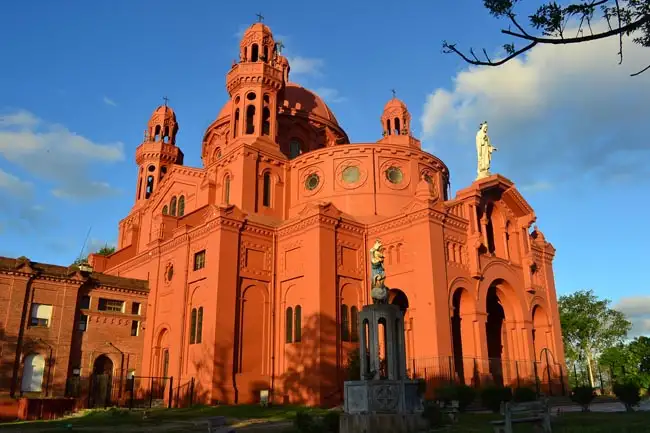
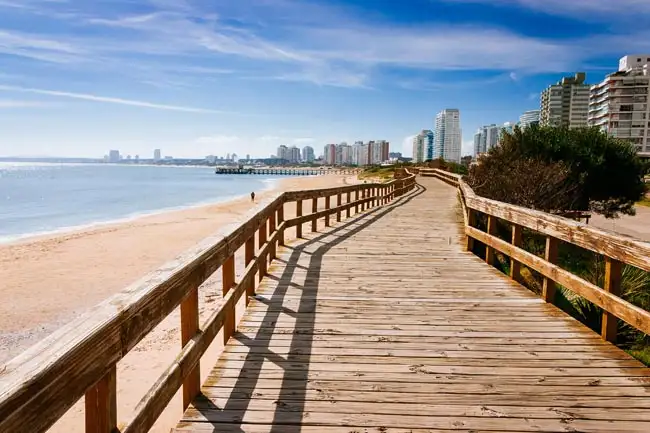
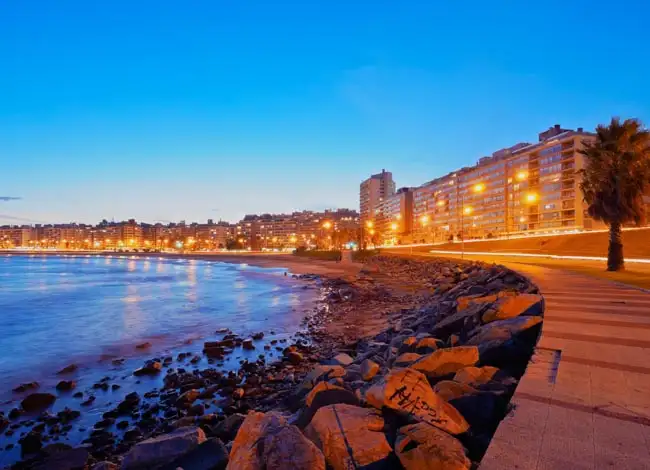
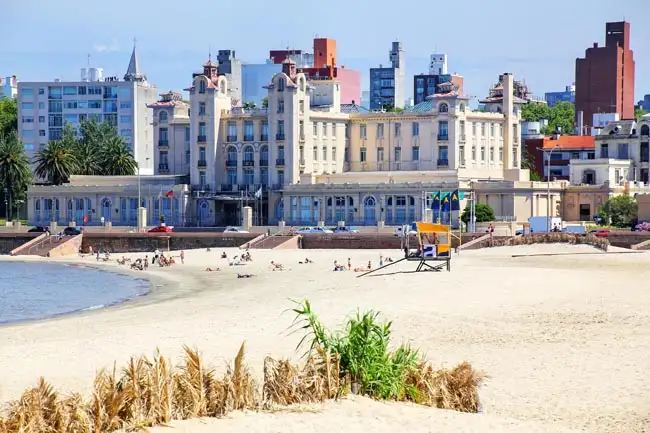
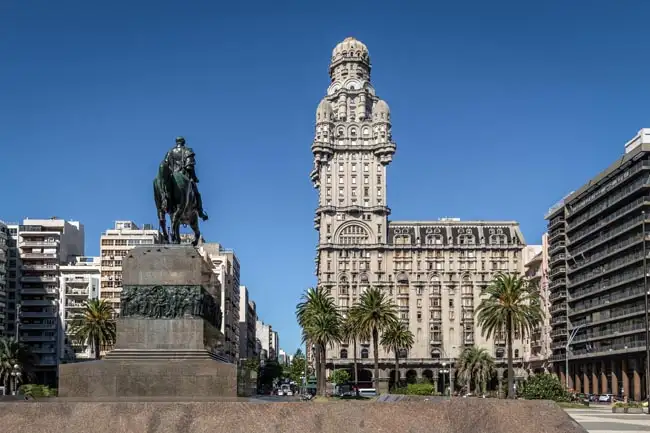
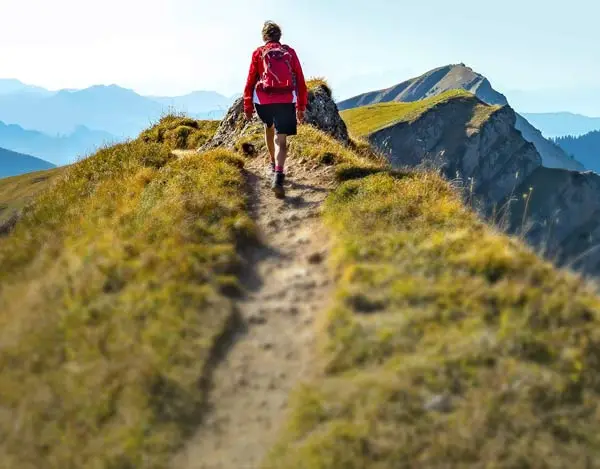
Book This Tour
- Final payment: Due 90 days prior to departure.
- Deposit: A non-refundable $1000 CAD Deposit is required at booking.
- Internal Flight Taxes: An extra $200 CAD applies for taxes and fees on tour flights. The internal airfares are included, but taxes are listed separately as they may change. Exceptions are noted in Red.
- Optional Single Supplement: $2730 CAD (number of singles limited).
(View options forsingle travellers) - $1000 deposit required due to nature of internal flights; additional $1000 pre-payment upon 'guarantee." Once paid, both your deposit and $1000 pre-payment becomes 100% non-refundable/non-transferable.
Prices below are per person, twin-sharing costs in Canadian Dollars (CAD). Pricing does not include airfare to/from the tour and any applicable taxes.
Tourcode: UP2
Frequently Asked Questions
- What is the maximum number of participants on a trip?Most of our tours carry a maximum of 18 participants; some tours (ie hiking tours) top out at 16. In the event that we do not achieve our minimum complement by our 90-day deadline, we may offer group members the option of paying a "small-group surcharge" as an alternative to cancellation. If all group members agree, we will confirm the trip at existing numbers; this surcharge is refundable in the event that we ultimately achieve our regular minimum. If the small group surcharge is not accepted, we will offer a refund of your deposit or a different trip of your choice.
- Can I extend my tour either at the beginning or end? What about stopovers?Yes, you can extend your tour either at the beginning or the end and we can book accommodation in our tour hotel. Stopovers are often permitted, depending on air routing. Stopovers usually carry a "stopover" fee levied by the airline.
- How do I make a reservation? How and when do I pay?The easiest way to make a reservation is via our website; during office hours, you are also more than welcome to contact us by telephone.
A non-refundable deposit is payable at the time of booking; if a reservation is made within 90 days, full payment is required. Some trips require a larger deposit. If international airline bookings require a non-refundable payment in order to secure space or the lowest available fare, we will require an increase in deposit equal to the cost of the ticket(s).
Early enrolment is always encouraged as group size is limited and some trips require greater preparation time.
Once we have received your deposit, we will confirm your space and send you a confirmation package containing your trip itinerary, any visa/travel permit related documents, invoice, clothing and equipment recommendations, general information on your destination(s), and forms for you to complete, sign and return to us. Your air e-tickets (if applicable), final hotel list, final trip itinerary, and instructions on how to join your tour, will be sent approximately 2-3 weeks prior to departure. - What about cancellations, refunds, and transfers?Please review our cancellation policy page for details.
- I am a single who prefers my own room. What is a single supplement?All of our tours have a single supplement for those who want to be guaranteed their own room at each location.
This supplement is a reflection of the fact that most hotels around the world do not discount the regular twin-share rate for a room by 50% for only one person occupying a room. Most hotels will give a break on the price, but usually in the range of 25-30% of the twin-share rate. This difference, multiplied by each night, amounts to the single supplement.
The conventional amount can also vary from country to country and some destinations are more expensive than others for single occupancy. In order to be "single friendly," the supplements we apply are not a profit centre for us and we do our best to keep them as reasonable as possible.
On most tours we limit the number of singles available, not to be punitive, but rather because many hotels allow for only a limited number of singles; some smaller hotels at remote locations also have a limited number of single rooms available.
Please note that most single rooms around the world are smaller than twin-share rooms and will likely have only one bed. - Do you have a shared accommodation program?Yes! If you are single traveller and are willing to share, we will do our best to pair you with a same-gender roommate. Please note that should we fail to pair you, we will absorb the single supplement fee and you will default to a single room at no extra charge.
